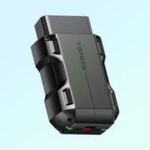The modern car is essentially a computer on wheels, relying heavily on complex electronic systems to function. These systems communicate through various networks, and understanding the difference between them, particularly OBD and OBD2, is crucial for diagnostics and maintenance. This article explores the distinction between OBD and OBD2, focusing on the “Obd Obd2 Unterschied” (OBD OBD2 difference) for clarity.
Bus Systems: The Foundation of Automotive Communication
Electronic components in a vehicle communicate through wires, transmitting signals to control various functions. To minimize complexity and reduce the sheer volume of wiring, bus systems were developed. A bus system allows multiple signals to travel over a shared network of wires, much like a public transportation bus carries many passengers. This significantly reduces the number of wires required, leading to lighter and more cost-effective vehicles. The most prominent bus system in modern vehicles is the Controller Area Network (CAN bus).
CAN Bus: The Highway of Automotive Data
CAN bus is a robust and reliable communication protocol used extensively in modern vehicles. It enables various electronic control units (ECUs) to communicate with each other in real-time, sharing critical data for engine management, transmission control, braking systems, and more. CAN utilizes two wires to transmit data, making it a highly efficient and cost-effective solution.
OBD-II: The Diagnostic Language
OBD-II, or On-Board Diagnostics, is a standardized system that provides access to a vehicle’s diagnostic data. Think of it as the language used to communicate with the car’s computer. It allows technicians and car owners to retrieve information about the vehicle’s health, identify potential problems, and monitor emissions performance. OBD-II utilizes a standardized connector, typically located under the dashboard, making it easy to access diagnostic information.
OBD vs. OBD2: Key Differences
While often used interchangeably, OBD and OBD2 are not the same. OBD refers to the general concept of on-board diagnostics, while OBD2 is a specific implementation of this concept. OBD2, introduced in the mid-1990s, standardized the diagnostic connector, communication protocols, and diagnostic trouble codes (DTCs). This standardization ensures that any OBD2 scanner can be used to diagnose any OBD2 compliant vehicle, regardless of make or model.
Using an OBD-II Scanner with CAN
Since CAN is one of the transport protocols utilized by the OBD-II standard, most OBD-II scanners readily support CAN. Connecting to a vehicle with CAN is as simple as plugging the scanner into the standardized OBD-II port.
Conclusion: OBD2 Leverages CAN for Diagnostics
Understanding the “obd obd2 unterschied” clarifies that OBD2 is a standardized diagnostic system that often utilizes CAN as its underlying communication protocol. OBD2 provides a universal language for accessing vehicle diagnostic data, leveraging robust technologies like CAN to enable efficient troubleshooting and maintenance.

